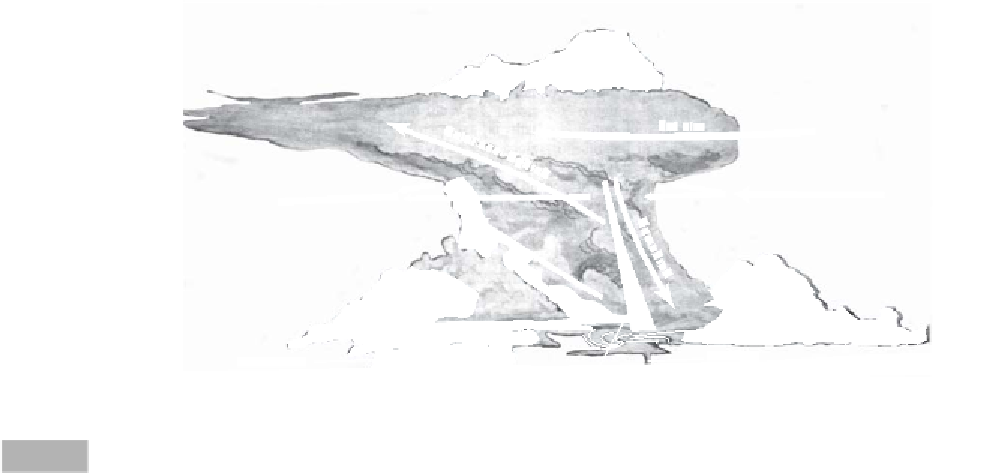Geoscience Reference
In-Depth Information
over thousands of kilometers, and last for up to two
weeks. However, tornadoes move faster than cyclones
and generate higher wind velocities. Tornadoes move
at speeds of 50-200 km hr
-1
and generate internal
winds at speeds exceeding 400-500 km hr
-1
. Torna-
does, similar to tropical cyclones, are almost always
accompanied by heavy precipitation.
updraft. As the downdraft expands, it collapses the
supercell and at this point the tornado descends to
the surface.
Dust devils, mountainadoes, fire tornadoes and
waterspouts
There are also a number of small vortex phenomena
that do not originate under the above conditions. Hor-
izontal vortices tend to form over flat surfaces because
air at elevation moves faster and overturns without the
influence of frictional drag at the Earth's surface. If
the horizontal vortex strikes an obstacle, it can be split
in two and turned upright to form a dry tornado-like
vortex (Figure 4.8). Because of its small size, Coriolis
force does not affect these vortices, so they can rotate
either clockwise or counterclockwise. On very flat
ground, where solar heating is strong, thermal convec-
tion can become intense, especially in low latitudes. If
the rate of cooling with altitude of air over this surface
exceeds the usual rate of -1°C per 100 m (the normal
adiabatic lapse rate), then the air can become very
unstable, forming intense updrafts that can begin to
rotate. These features are called 'dust devils' or, in
Australia, 'willy-willys'. While most dust devils are
not hazardous, some can intensify downwind to take
on tornado-like proportions. Tornado-like vortices can
also be generated by strong winds blowing over
topography. Strong wind
shearing
away from the top of
an obstacle can suck air up rapidly from the ground.
Such rising air will undergo rotation, forming small
vortices. Around Boulder, Colorado, strong winds are
For
m and formation
(Nalivkin, 1983; Grazulis, 1993)
Supercell tornado formation
By far the best-studied and most common process of
tornado formation is that associated with supercell
thunderstorms. The
parent cloud
may be 15-20 km in
diameter with strong rotational uplift that pierces the
stratosphere as a dome cloud capping the storm
(Figure 4.7). This mesocyclone links to the jet stream
producing an anvil shape that is skewed in the direc-
tion of movement. As precipitation falls from the storm
it cools air, which sinks to the ground in front of
the storm producing a gust front that precedes the
thunderstorm. Destructive winds in this zone are
known as a downburst and when they hit the ground
can produce dangerous wind shear. Drier air behind
the thunderstorm is drawn into the mesocyclone in
the middle atmosphere. This evaporates cloud, giving a
sharply defined outline to the storm. More importantly,
evaporation causes the air to cool, become unstable
and cascade to the ground as a downdraft. Tornadoes
develop between this rear downdraft and the main
16
14
12
10
Dry air inflow
8
6
4
2
o
0
Zone of tornado formation
East
Generation of a tornado within a supercell thunderstorm (after Grazulis, 1993).
Fig. 4.7











































































































